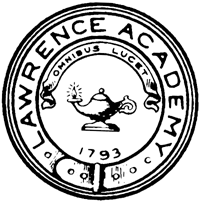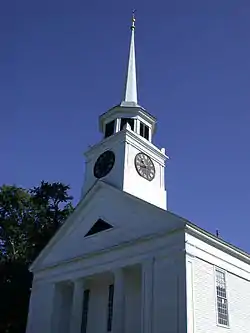Lawrence Academy (Groton, Massachusetts)
Lawrence Academy at Groton is a private, nonsectarian, coeducational college preparatory boarding school located in Groton, Massachusetts, in the United States. Founded in 1792 by a group of fifty residents of Groton and Pepperell, Massachusetts as Groton Academy, and chartered in 1793 by Governor John Hancock, Lawrence is the tenth oldest boarding school in the United States, and the third in Massachusetts, following Governor Dummer Academy (1763) and Phillips Academy at Andover (1778).[1] The phrase on Lawrence Academy's seal is "Omnibus Lucet": in Latin, "Let light shine upon all."
| Lawrence Academy | |
|---|---|
 | |
| Address | |
26 Powderhouse Road , 01450 | |
| Coordinates | 42°36′14″N 71°33′58″W |
| Information | |
| Established | 1793 |
| Head of School | Dan Scheibe |
| Faculty | ~80 |
| Enrollment | 400 |
| Campus type | Exurban |
| Color(s) | Red and Blue |
| Nickname | Spartans |
| Rivals | Tabor Academy, Groton School (Unofficial) |
| Website | www |
History
On April 27, 1792, residents of the towns of Groton and Pepperell, Massachusetts,[2] influenced by the growing "academy movement" in the young republic, which sought to provide a broader and more practical education than that available in the traditional Latin Grammar Schools,[3] formed an association "for the purpose of erecting a suitable building, and supporting an Academy for superior educational purposes at Groton, Massachusetts."[4] The association received its charter from Governor John Hancock on September 28, 1793.[5] Originally, the school was called Groton Academy, but was later changed to honor the Lawrence family.
For the academy's first schoolmaster, the trustees selected Samuel Holyoke, a prominent composer. He was a graduate of Phillips Academy and Harvard college.
The trustees announced the opening of their academy with an advertisement in the May 25, 1793 edition of the Columbian Centinel, a Boston newspaper; this was somewhat premature, as the charter was not secured for another four months.
The advertisement expressed the values of the academy movement, reading in part:
This is to give notice, that a Public School is now opened in Groton, for the education of youth, of both sexes—in which School are taught the English, Latin and Greek Languages, Writing, Arithmetic, Geography, the Art of Speaking and Writing, with Practical Geometry, and Logic.[4]
Classes commenced in 1794, with an enrollment of seventy-three students, primarily from Groton and the surrounding towns. Some, such as Thomas and Wyriott Alderson of Bath, North Carolina, came from farther afield.[4]
In 1838, alumnus Amos Lawrence, a son of founder Samuel Lawrence and a prominent Boston merchant and industrialist, began his patronage of the Academy with a gift of "books and philosophical apparatus," followed in 1839 by "a telescope and Bowditch's translation of Mécanique Céleste by Laplace," and $2,000 for enlarging the schoolhouse in 1842.[6] In 1844, Amos's brother William donated $10,000 to the school's endowment "for the advancement of education for all coming time."[6]

By 1850, the school's library, established with a purchase of 86 new books in 1828, comprised 2,650 volumes, of which 2,400 were gifts of Amos Lawrence.[7]
Over the course of their lives, Amos and William Lawrence donated a total of nearly $65,000 in cash, scholarships, and property to the school (roughly equivalent to $1.83 million in 2013 dollars).[6] In recognition of their significant generosity, Groton Academy petitioned the Massachusetts legislature in 1845 to change the school's name to honor their benefactors. On February 28, 1846, Governor George N. Briggs signed into law an act formally changing the corporate name of "The Trustees of the Groton Academy" to "The Trustees of the Lawrence Academy at Groton."[5]
Between 1801 and 1870, Lawrence Academy contributed fifty students to Harvard College and placed among the dozen schools which supplied the greatest number of students to Cambridge. As the 19th century progressed and more schools catering to the children of the elite ranks of Boston merchants and industrialists were established closer to Boston, that position gradually waned.[8] The Academy also enjoyed close ties to other New England liberal arts colleges — particularly Dartmouth and Williams College — which themselves catered to the region's "older provincial elite".[8] The gifts of the Lawrence brothers established four scholarships each for students to attend Williams College, Bowdoin College in Maine, and Wabash College in Indiana.[6] Franklin Carter, president of Williams College, was the guest speaker at the academy's 90th anniversary celebration in 1883.[4]
In 1868, during a Fourth of July celebration, an errantly tossed firecracker burned Lawrence Academy's main schoolhouse to the ground. By soliciting "subscriptions," the building was replaced in 1869 at a cost of $24,000 (more than $406,874 in 2013).[6]
In 1956, amidst commencement exercises, fire once again destroyed Lawrence Academy's academic and administrative buildings. Following both fires, Lawrence Academy rebuilt; however, because of these incidents, it encountered financial difficulties through parts of the twentieth century, until the late 1970s. Lawrence was coeducational until 1898, when it switched to a boys-only student body. It remained single sex until 1971.
Athletics
Lawrence Academy's athletic teams compete in the Independent School League.
Notable alumni
- Tim Armstrong, class of 1989, chairman and CEO of AOL LLC
- Laurie Baker, class of 1995, 1998 Olympic gold medalist in women's hockey and 1992 silver medalist
- William Bancroft, 1st President of the Boston Elevated Railway, member of Massachusetts House of Representatives and mayor of Cambridge, Massachusetts
- Jonah Bayliss, relief pitcher for Kansas City Royals 2005 and Pittsburgh Pirates 2006 and '07.
- Charles Beecher, minister, composer of hymns, and author.
- Tyler Beede, 2014 College World Series champion Vanderbilt University; drafted twice as pitcher in the MLB draft first round, and pitches for the San Francisco Giants
- Henry Adams Bullard, U.S. Representative from Louisiana 1831-1834 and 1850-1851
- Richard Burgin, author, editor of Boulevard
- Karyn Bryant, television personality; MTV VJ, CNN anchor
- Jim Campbell '91, former professional hockey player
- Guillermo Cantú, former professional footballer and football executive
- Bruce Crane, businessman and politician who was president and chairman of Crane & Co. and a member of the Massachusetts Governor's Council
- Greg Crozier, two-time NCAA hockey champion from Michigan (1996 and 1998)
- James Dana, 5th mayor of Charlestown, Massachusetts
- A. J. Dillon, American football running back for the Green Bay Packers, second round pick in the 2020 NFL Draft.
- Doug Friedman, professional ice hockey player
- Eric Gaskins, fashion designer based in New York City
- Samuel Abbott Green, physician, librarian, historian, and 28th Mayor of Boston
- Donald L. Harlow, Chief Master Sergeant of the Air Force
- Edward D. Hayden, U.S. Representative from Massachusetts
- Steve Heinze '88, Olympian in men's hockey and former NHL player for Boston Bruins and LA Kings
- Frederick "Moose" Heyliger, World War II paratrooper featured in Band of Brothers
- Vic Heyliger, U.S. Hockey Hall of Fame inductee; University of Michigan All-American and later coach of six NCAA champions at Michigan; also coached Illinois, Air Force Academy and the U.S. National Hockey Team
- Chase Hoyt, film, television, and stage actor
- David Jensen, class of 1984, '84 Olympian in hockey and former NHL player with Hartford Whalers and Washington Capitals
- Amos Kendall, 8th Postmaster General and founder of Gallaudet College for the deaf
- Abbott Lawrence, Member of Congress; Minister to Great Britain; founder of Harvard University's Division of Engineering and Applied Sciences
- Amos Adams Lawrence, abolitionist; politician; founder of the University of Kansas, Lawrence University, and co-founder of the Groton School
- Amos Lawrence, industrialist; philanthropist
- Charles H. Mansur, member of the U.S. House of Representatives from Missouri
- Cat Marnell, writer
- Julie Mason, newspaper and radio journalist
- Page McConnell, Phish musician
- Audrey A. McNiff, managing director at Goldman Sachs
- Shabazz Napier, former NBA basketball player
- Rand Pecknold, NCAA head hockey coach
- Albert E. Pillsbury, President of the Massachusetts State Senate and Massachusetts Attorney General
- William Adams Richardson, 29th Secretary of the Treasury and Chief Justice of the United States Court of Claims
- Richard Roby, professional basketball player
- Maria Rodale, publisher; Chairman and CEO of Rodale, Inc.
- Cynthia Ryder, 1992 Olympic sculler
- Jeff Serowik '86, former professional hockey player
- Ether Shepley, politician; Senator from Maine from 1833-1835, Chief Justice of the Maine Supreme Judicial Court 1848-1855
- Jim Sokolove, television attorney
- Huntley N. Spaulding, philanthropist; Governor of New Hampshire from 1927 to 1929
- Charles Warren Stone, politician; Congressman and Lieutenant Governor from Pennsylvania
- Frank Bigelow Tarbell, historian, archeologist and professor at University of Chicago
- George Makepeace Towle, lawyer, politician, and author
- Dr. James Walker, Unitarian minister and 21st president of Harvard University
- William B. Washburn, Governor of Massachusetts from 1872-1874, U.S. Representative from 1863-1871, U.S. Senator from 1874-1875
- Fritz Wetherbee, Emmy Award-winning television personality
- William Channing Whitney, architect
- Antoine Wright, former NBA basketball player
Notable faculty
- Samuel Adams Holyoke, first headmaster
- Robert V. Bruce, 1988 winner of the Pulitzer Prize for History
- Brian Feigenbaum, founder of Food Not Bombs
- Paul Zukauskas, former Boston College football and Cleveland Browns player who coached at Lawrence Academy, leading the team to four consecutive ISL and two additional NEPSAC championships
References
- Boarding Schools with the Oldest Founding Date – All Schools Archived July 17, 2012, at the Wayback Machine. Retrieved February 20, 2009.
- The Jubilee of Lawrence Academy at Groton, Standard Steam Presses, 1855.
- Inglis, Alexander. Principles of Secondary Education. Houghton Mifflin Company, 1918
- Sanderson, George A., ed. A General Catalogue of the trustees, teachers, and students of Lawrence Academy, Groton, Massachusetts, from the time of its Incorporation, 1793-1893. Lawrence Academy, 1893
- Acts Relating to Lawrence Academy, Groton, Massachusetts. University Press, 1894
- Financial History of Lawrence Academy, John Wilson & Son, Cambridge, Mass., 1895.
- Catalogue of the Library of Lawrence Academy, Groton, Mass. 1850, S.J. Varney, Lowell, Mass., 1850
- "Story, Ronald, Harvard Students, the Boston Elite, and the New England Preparatory System, History of Education Quarterly, Vol. 15, No. 3 (Autumn 1975). Accessed March 4, 2014 (subscription required)
Further reading
- Massachusetts Board of Education; George A. Walton (1877), "Report on Academies: Lawrence Academy", Annual Report...1875-76, Boston – via Internet Archive
{{citation}}: CS1 maint: location missing publisher (link)
External links
- Official website
- The Association of Boarding Schools profile
- Lawrence Academy profile at Petersons.
- Gibbet Hill history.
- Lawrence Academy on Twitter
- Lawrence Academy on Instagram. Archived from the original on ghostarchive.org